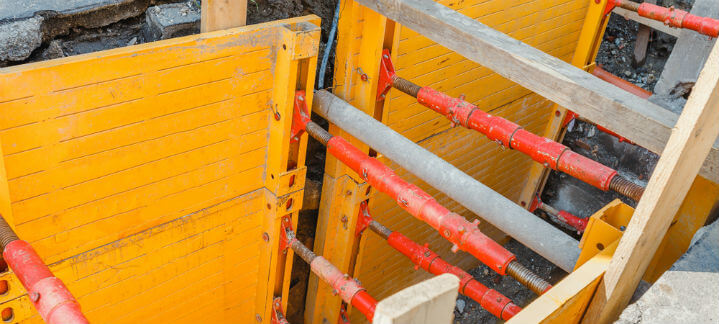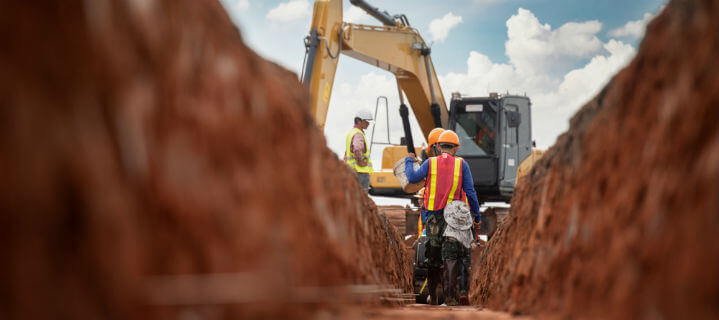Excavation and trenching are among the most hazardous construction activities. The Occupational Safety and Health Administration (OSHA) has defined specific safety standards for excavation and trenching projects. These regulations are outlined in OSHA 1926 Subpart P, which focuses on excavation safety.
What Is Excavation?
OSHA defines excavation as any man-made cut, trench, cavity, or depression made in the earth’s surface through earth removal activities.
OSHA Excavation Standards
The OSHA excavation standards apply to any open excavation on the earth’s surface. These standards help reduce or prevent risks of excavation-related and cave-in incidents.
The OSHA excavation standards need a competent person to evaluate and classify soil rock and deposits on the surface, i.e.,
- Stable Rock
- Type A Soil
- Type B Soil
- Type C Soil

What Is Trenching?
According to OSHA, a trench is a narrow excavation (compared to its length) made beneath the ground’s surface. Usually, a trench’s depth is larger than its width, whereas the width at the bottom is never greater than 4.6 meters or 15 feet.
OSHA Trench Regulations
The cave-in and collapsing incidents in the trenches can risk your workers’ lives. Thus, safe trenches can reduce workers’ exposure to hazards such as falling loads, falls, hazardous atmospheres, etc.
OSHA requires employers to comply with trenching and excavation requirements of 29 CFR 1926.651 and 29 – CFR 1926.652 or any other OSHA-compliant state safety standards.
How Deep Can a Trench Be Without Shoring?
Trenches with a depth of 5 feet (1.5 meters) or greater need a protective system unless the entire excavation is in stable rock. If there is anything less than 5 feet, it is up to a competent person’s discretion to determine if there is a need for a protective system.
A trench with a depth of 20 feet (6.1 meters) or greater needs a protective system. However, a registered professional engineer must design this protective system.
If that is not possible, you can create a protective plan based on tabulated data and configuration evaluated, approved, and prepared by a registered professional engineer as per 29 CFR 1926.652(b) and 29 CFR 1926.652(c).
5 Common Trenching and Excavation Hazards
Trenching and excavation work has various dangers that require careful management to ensure worker safety. Here are five of the top hazards associated with the high-risk field.
1. Cave-ins
Do you know cave-in incidents kill two workers per month on average? These stats make them a serious hazard to your workers’ safety.
Thus, OSHA requires a registered professional engineer to analyze the soil composition before any excavation and trenching activity. The job of this professional engineer is to design and implement a protective system that slopes, shields, and supports the structure.
2. Vehicles
Construction vehicles such as backhoe loaders and dump trucks also pose a threat to your workers. The operators of these vehicles may have an obstructed view at times while approaching trenches. Thus, OSHA recommends designing a flagger or spotter to direct the vehicles.
3. Hazardous Atmospheres
Oxygen levels may be depleted within the trenches. So, you must take precautionary measures to deal with such occurrences. Any excavation exceeding 4 feet requires atmospheric testing by a registered professional per OSHA’s standards.
4. Falls or Falling Objects
Working equipment and workers can fall in an excavated area; thus, install a site safety sign or preferably a barrier around the excavation’s parameter as a warning sign.
Similarly, equipment, overhead loads, or excavated dirt can fall into a trench and crush people working below. So, OSHA requires you to store any job site material at least 2 feet away from the excavation or trenches’ edge.
5. Utility Lines Hazard
Sometimes, excavation and trenching can cause exponential damage to municipal fixtures such as utility lines. It can result in natural gas leaks and electrocution and cause fatalities.

6 Top Trenching and Excavation Safety Tips
Here are six tips for safe excavation and trenching operations to get you started.
1. Excavation and Trenching Safety Training
You must not simply design a safety system and assign personnel to conduct necessary checks. It is of utmost importance for you to train your employees regularly about health and safety.
2. Keep a Competent Person On-site
Always appoint and designate a competent person on-site for ongoing site safety evaluations. This person should have relevant training on trenching and excavation safety standards and be able to communicate safety practices to other employees.
3. Provide Proper Entry and Exit Points
There must be plenty of entry and exit points for the designated number of workers, and make sure to mark them so that all workers know where they are. This is very important in case of emergencies and incidents.
These “access and egress” points must be placed within 25 feet of workers for trenches four feet or deeper, according to OSHA standards.
4. Use Appropriate Safety Systems
There are several protective systems you can use, such as:
- Sloping – involves cutting the trench’s wall at an inclined angle away from the excavation.
- Shoring – requires the installation of an aluminum hydraulic or other supports to prevent cave-ins
- Shielding – protects your workers by using supports such as trench boxes to avoid cave-ins
To sum up tip #3, you need a safety and risk management consultant for a thorough and professional worksite analysis and design of an appropriate protective system.
5. Protect Yourself
Never enter an unprotected trench; OSHA requires a professional for a job safety analysis of the site before allowing anyone in.
6. Practice General Excavation Safety
Apart from all the above tips, always use common sense and practice other general excavations or health and safety rules for the safety of your site and, most importantly, your workers.
Let Safety By Design Manage Your Excavation and Trenching Safety
Leave the safety of your excavation and trenching projects to the experts. Safety By Design specializes in safety training services in Houston. With our experience and dedication, you can have peace of mind knowing that your team and site are protected.
Get in touch today to learn more about our safety management services.



